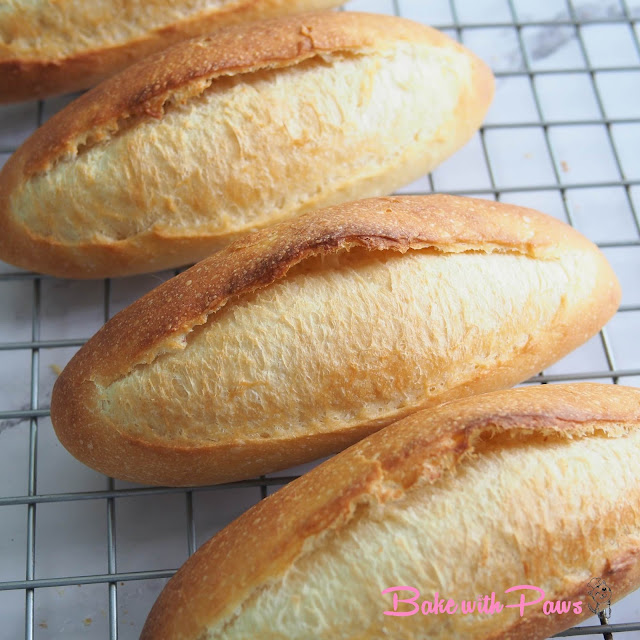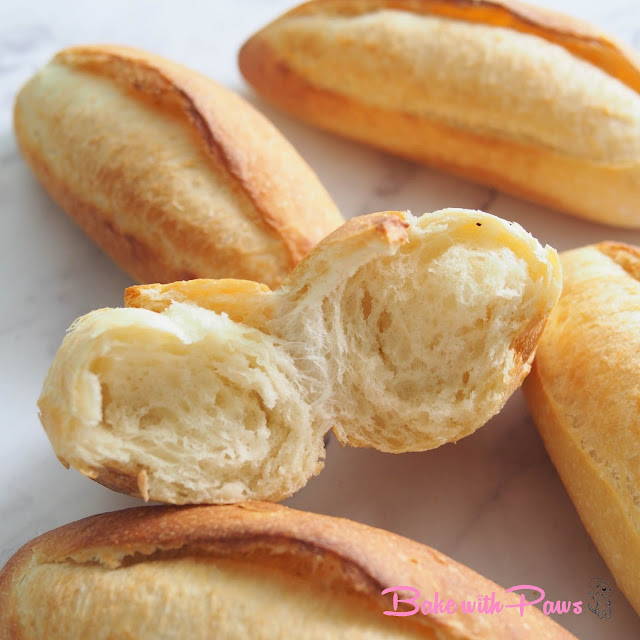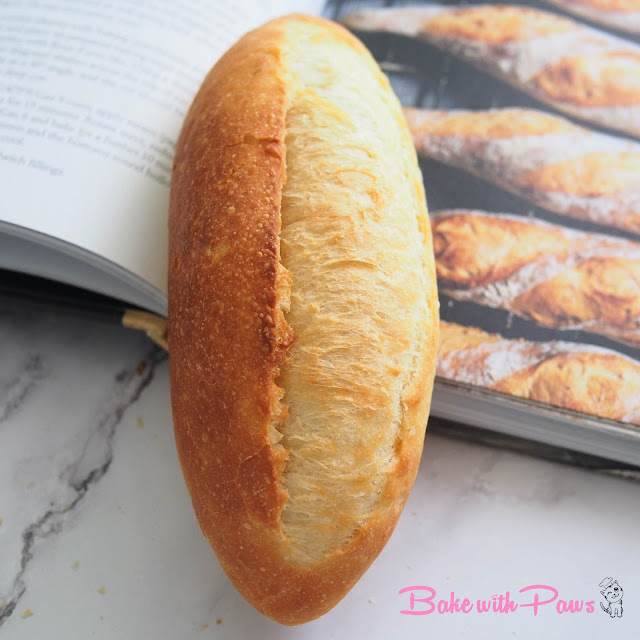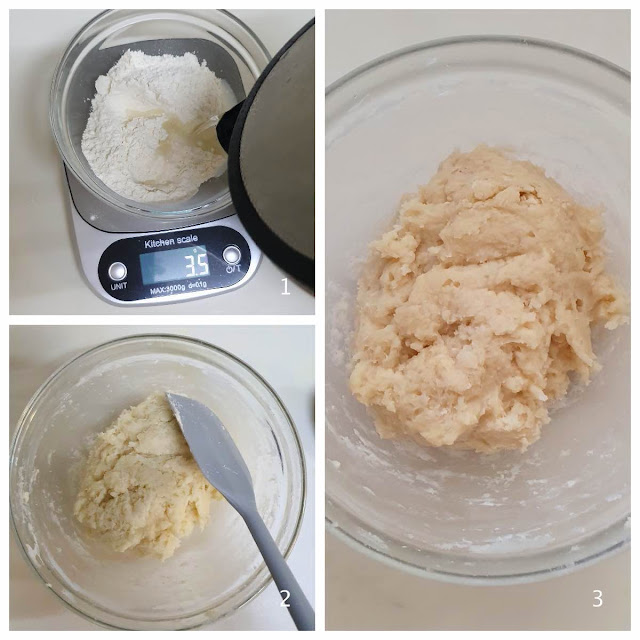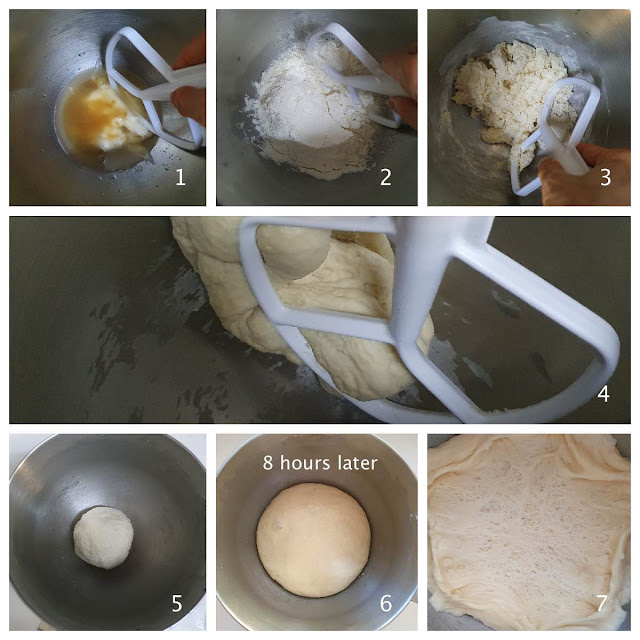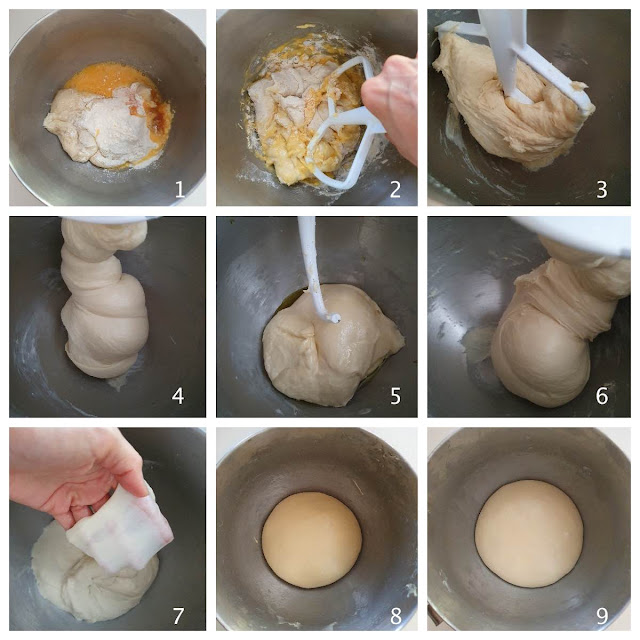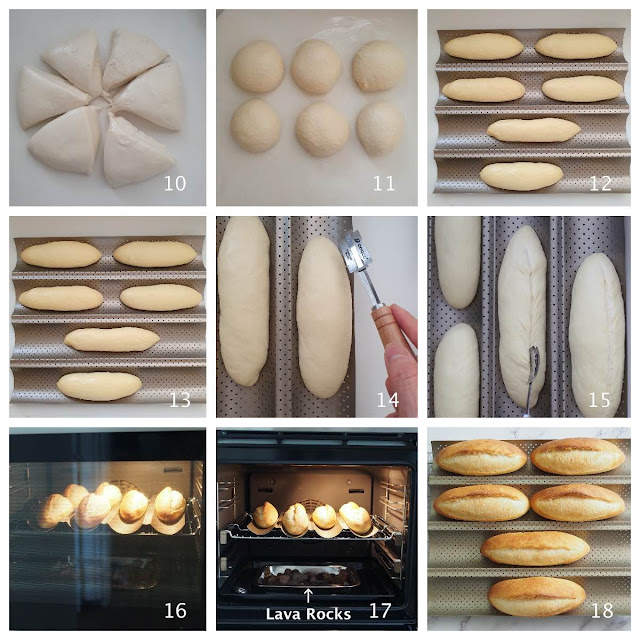I have attempted Sourdough Banh Mi (Vietnamese Baguette) several times with egg, eggless as well as egg white only. I found that the recipe with egg is probably better as I get a more fluffy crumb. The bread does however have a more eggy aroma when I used the whole egg compared to egg white alone. It could just be our eggs though? The picture shown above is with whole egg.
I used Sweet Stiff Starter and Yudane Method as a combination of my favourite methods. The Yudane Method yields a very moist, soft and fluffy texture.
The crust is very crispy when it is warm. However it becomes soft after it completely cools down. Please toast the bread to get back the crispy crust if not eating it fresh out of the oven.
If you have any questions regarding this recipe or any other post, please leave me a comment in the “LEAVE A COMMENT” link and I will reply you as soon as possible. Do tag me on Instagram @Bakewithpaws if you attempt on this recipe.
RECIPE - SOURDOUGH BANH MI (VIETNAMESE BAGUETTE)
Yields: 6 rolls
INGREDIENTS:
Yudane Dough:
80g bread flour (I used Japan High Gluten Flour)
80g boiling water
Sweet Stiff Starter (50% Hydration):
70g sourdough starter (100% Hydration), preferably use at its peak
215g bread flour (I used Japan High Gluten Flour)
90g water
35g sugar (I used organic brown sugar)
Main Dough:
70g bread flour (I used Japan High Gluten Flour)
All stiff starter (above)
All the yudane dough (above)
1 1/2 tsp (8g) salt
70g egg and water mixture (1 egg + water)
10g vegetable oil (I used extra virgin olive oil)
Utensil:
Baguette Tray (4 Wave, Slot Diameter 7.5 cm)
Lava rocks
METHOD:
- Yudane:
- Add bread flour in a bowl, pour the boiling water and mix well with spatula or spoon until no dry flour.
- Cling film and place in the fridge for at least 4 hours or overnight. I prepared the night before.
- Take out from the fridge 30 minutes before using to return to room temperature.
- Sweet Stiff Starter
- Dilute starter with water, stir in sugar and mix in bread flour to become a dough. Please use stand mixer with paddle attachment to mix if you find hard to mix with hand.
- Cover and let it ferment until tripled. I prepared a night before and leave it in aircond room (approximately 24 - 25C room temperature) overnight until tripled. It took about 8 hours depending on your starter. You can also prepare and leave on your kitchen counter, let it rise until triple in several hours and use at its peak. The starter should look smooth and round dome. It shouldn't have any dimples or it shouldn't collapse.
- Main Dough:
- Put all ingredients (except butter/olive oil), including all the stiff starter and yudane dough into a bowl of stand mixer. I usually torn the stiff starter and yudane dough slightly.
- Slightly combine the mixture by hand with the paddle attachment before turning on the machine so that the flour will not splash out. Using the paddle attachment, mix for 2 minutes or until all incorporated. This step is critical to prevent an uneven mixed dough as the stiff starter is rather hard and a dough hook may not be able to mix it well enough.
- Change to hook attachment and knead for another 3 minutes or until the dough comes together. Add in butter and continue knead for 10 - 12 minutes or until reach window pane stage. The whole kneading process, I stopped few times to scrape down the dough from the hook to be sure it is evenly kneaded and also to prevent the motor from overheating.
- 1st Proofing/Resting:
- In the same bowl, let the dough rest for 15 - 60 minutes. Keep it covered with clingfilm or use a lid. This dough I rested for 45 minutes and the dough rose slightly in 45 minutes. (I did not find any big differences between 15 minutes to 60 minutes rest. So, please follow your schedule).
- Shaping:
- Transfer the dough to a clean floured surface then divide dough into 6 equal portions. Please use a kitchen scale if you want to be exact.
- Form each portion to a ball. Please watch the video "How To Shape & Score Bahn Mi"
- Place the bread dough onto the baguette tray.
- Final Proofing:
- Let the rolls proof at a warm place until the dough rise about double in size. This one took approximately 2 hours and 15 minutes at at room temperature of 29C. The duration of proofing depends on your ambient temperature and starter.
- Baking:
- Preheat oven with baking stone and lava rocks at 200C (fan-forced) for 30 minutes before baking.
- Once the oven is ready, score the dough (please watch the video). Wet the blade with water for easy scoring. Keep the blade at 45° angle, and slash across the dough lengthwise.
- Spray water on the rolls and bake immediately.
- Open the oven door, place the bread dough (with the baguette tray).
- Pour one cup of hot water into the lava rocks.
- Close the door immediately.
- Reduce temperature to 190C (fan-forced) and bake for about 20 minutes or until golden brown. Rotate the Bahn Mi if the oven heat is uneven.
- Remove Bahn Mi from oven and let them cool on rack.
Note: If lava rocks are not available, please use empty tray and pour hot water in it. However, lava rocks is more effective to create steam.
Yudane Dough
GENERAL NOTES:
SOURDOUGH STARTER
A healthy starter is very crucial as advised by Baking with Gina. It is advisable to feed your starter regularly if you want your bread to rise nicely and to use the starter (levain) at its peak. A starter that is fed regularly will be more active in general. If the mother starter is not strong, the bread dough will not rise a lot even though the starter is used at its peak.
There are so many ways and methods of how to maintain the starter. Below is my method of starter maintenance. This is just for your reference. Please try and find a way or schedule that works best for you.
I bake almost everyday. So, my starter is left at room temperature and I feed it twice a day every 12 hours at its peak when it is tripled.
Example
10.00 am - at ratio 1:10:10 at room temperature 26C - 27C
10.00 pm - at ratio 1:10:10 at room temperature 25C - 26C
I feed a very small amount of 1g starter + 10g water + 10g flour if I am not baking, so that I will not end up with too much discard. When I am baking, I will feed the starter accordingly to make up the quantity required by the recipe to be baked. If I know that I won't be baking for a few days, I will then feed it only once a day at 1:10:10, transfer to the fridge when it is doubled, and feed again 24 hours later.
If you do not bake daily or if you bake perhaps once or twice a week, then you may place your starter in the fridge and feed once a week. But, you will need to refresh your starter 2 days before the baking day. There is no way around this, sourdough baking takes planning!
How I judge my starter is healthy? My starter usually tripled in size (or at least double) in within 3 - 4 hours at room temperature (27C - 28C) for feeding ratio of (1:1:1 = starter:water:flour)
When is a starter at its peak? My sourdough starter is usually at its peak when it is tripled in the jar. The surface of my starter looks bubbling and uneven. It usually stays at its peak within 30 - 60 minutes before it starts to reduce/fall.
Why use starter at its peak? This is when the starter is most active and it will result in a better rise for your bread in general. By the way, you can use when it is doubled/before its peak too. But, not it starts to fall.
MILK POWDER
Why do I use milk powder?
- Milk or milk powder will enhance the flavour of the bread and makes the bread texture softer due to the fat content of the milk.
- Milk powder is shelf stable and you can have it anytime when you want to use. Unlike liquid milk you need to finish within a certain time before it spoils.
For kneading, please regard the timing provided as an indication only. It is only meant as a guide. Timing may differ depending on the brand of flour and electric mixer used. The protein content may vary from one brand of flour to another.
OVER KNEADING
Some have experienced the dough breaking during the second proofing. If that happens it is due to over kneading. Please stop the machine and check your dough during the final cycle of kneading to ensure that you don't over knead. Every machine is different and there is always a chance of over-kneading when using a machine. You may need to adjust this timing and stop as soon as you reach the window pane stage. This happen especially to Yudane dough method. I noticed that it is harder to achieve a very thin window pane with Yudane method dough.
FLOUR
The right flour plays a very important role in bread making. To achieve fluffy, soft and light bread, I used Japan High Gluten Flour in most of my bread baking. The protein content is around 12 - 13%.
HYDRATION
The liquid measurement given is also a guide. It is advisable to always reserve some liquid and not add it all in one go. This would give you the opportunity to adjust if necessary. If dough is too dry, add the reserve liquid one tablespoon at a time until the right consistency. This is because each flour absorbs water and hydrates differently.
PROOFING
Please note that the proofing timing may also vary depending on your climate, environment, flour and your starter.
If you are unable to judge by just looking at the dough, you can do the finger poke test:
Proofing:
- Lightly press the side of the proved dough with your finger. If it bounces back immediately without any indentation, it means the dough is under proved and needs more time before baking.
- If the indentation stays and it doesn’t bounce back, it means it has been over proved.
- If the indentation slowly bounces back and leave a small indentation, it is ready to bake.
- There will be a final burst of rising once the bread is placed to bake in the oven and it is called oven spring.
BAKING TEMPERATURE AND TIME
Do also note that the baking temperature and timing provided are what works for my oven and should also be regarded as a guide only. Every oven behaves a little differently, so please adjust accordingly for your oven.


